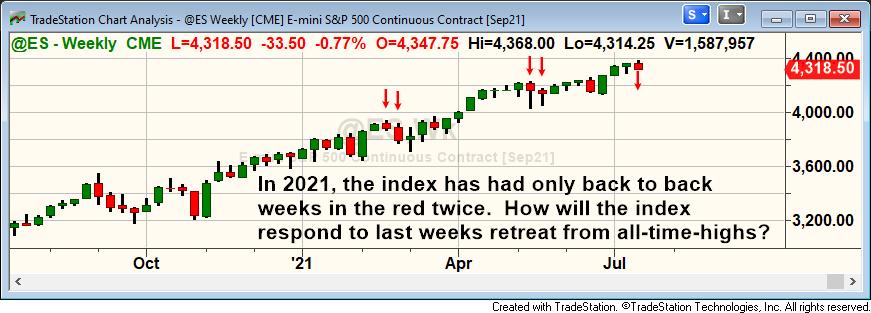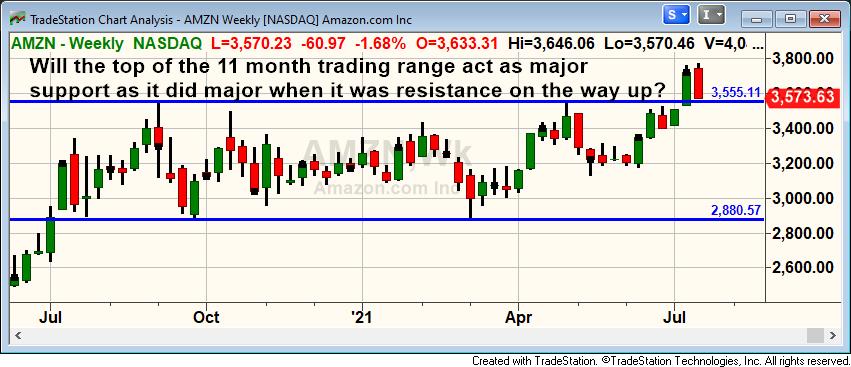Monday: Follow-Through, Like We Were Supposed To Do
On many occasions, when the S&P 500 index settles on the high or low for the week, it provides for a solid trading set-up. Either the index will sharply reverse course or continue with the prior week’s trend.
In early premarket trading, it appeared that a reversal was on the docket as the futures drifted lower until 4:00 AM EST, until it bottomed nearly 20 handles lower at 4341.25 and reversed course.
Following choppy price action until 11:00 AM, the index cleared the close for good (4360) and rallied to a new all-time high (4379.25) and all-time close by 16.50 handles at 4376.50.
Movers
After being unable to clear the psychological $700 level last week, Tesla Inc. (NASDAQ: TSLA), went into retreat mode. In fact, it went opposite of the S&P 500 index and made a new low for the week on Thursday ($620.46). That low was $15 lower than its former resistance level ($635), which was the key for a quick move to $700 earlier this month. It did rebound to close last week at $656.95.
Most of the weakness in the issue was attributed to the trepidation over the outcome of the lawsuit v. Tesla/Elon Musk over the controversial takeover of Solar City in 2016, before it was about to go under.
Musk’s smooth testimony boosted the confidence of Tesla investors that the company would prevail in the trial and issue gained $28.75 to close at $685.70. The rally sets the stage for another test of the major resistance at $700.
Tuesday: Turbulent Tuesday
Although it was a win for the bears on Tuesday, with S&P 500 finishing in the red, the bulls did not go down without a fight. Investors were able to erase the weakness in premarket trading instigated by the hotter than expected Consumer Price Data, nudging the index to a new all-time high (4383.75) midway through the session.
However, the combination of inflation fears and mixed earnings from the big banks, sparked profit-taking in afternoon trading. The index retreated from uncharted territory and went on to breach the premarket low late in the day. The index found buyers well above Monday’s low (4331.75) at 4356.50 and closed lower by 15.25 handles at 4361.50.
Movers
Goldman Sachs (NYSE: GS) which has been battling to get back to all-high levels, could not finish in the green after a blowout Q2 earnings report. The investing banking giant came under selling pressure as investors contemplate whether more subdued trading for the remainder of the year may put a crimp in future trading revenue. Also, the flurry of IPO and SPAC deals in the first half of the year, may not replicate itself in Q3 and Q4.
In a volatile session, the issue had $13.22 range, rallying the S&P 500 off the open, exceeding Monday’s high ($384), reaching $385.33 and reversed course. It should be noted that high marks the highest level for Goldman Sachs, since its June 13 ($348.13) low. That low ended the pullback from it’s all-time high which was made on June 7 ($396.26).
The issue was unable to hold the solid gains and drifted lower for the remainder of the session. The decline found support well ahead of Monday’s low ($367.03) at $372.01 and rebounded to end the session lower by $4.52 at $375.98.
Wednesday: Wacky Wednesday
The S&P 500 index was all over the place in Wednesday’s session. Steep premarket losses were erased and the index made a new all-time high early in the regular session by only a small margin (4383.75 vs. 4384.50).
However, the continued weakness in the banking sector along with declines in the energy sector offset some of the gains in the technology sector. After flirting with the premarket low (4350) late in the session, the index battled back to close higher by 6.50 handles at 4367.75.
Movers
For investors looking for a catalyst to reinvigorate the “reopening trade”, Delta Airlines (NYSE: DAL) price action after its Q2 report was not it. Delta fell 2% despite posting its first quarterly profit since the pandemic crushed the industry last year.
Before the report, the issue had already had a major retreat from its rebound high from March at $52.28 and headed into Wednesday’s session at $41.33. That was the lowest close during its recent pullback.
After a higher open, it failed to reach Tuesday’s high ($42.55) as the rally stalled at $42.30. The issue went on to surpass its former low for the move ($41.12) falling to $40.12. That low coincides with its February 4 low ($39.94).
Delta was able to rebound off the rebound off the psychological support level ($40) to only close lower by $.65 at $40.68.
Thursday: Correction Time, No So Fast
There were no clear catalysts after the close on Wednesday or in the premarket on Thursday to instigate a rally in early trading. The S&P 500 began the regular session in the red and drifted lower into the early afternoon, easily breaching Wednesday’s low (4350).
Cautious comments from Jerome Powell on inflation accelerated the pace of the decline in the afternoon, but found support heading into the final hour at 4332.50 and began to rebound.
The index did manage to trim some of its earlier losses, but ended the day well shy of the close, lower by 15.75 handles to close at 4352.
Movers
Over the past year, companies that have announced stock splits have had major rallies following the announcement. Perhaps Apple Inc. (NASDAQ: AAPL) and Tesla Inc. (NASDAQ: TSLA) are the best example from last year.
Before the open on May 21, Nvidia Corp. (NASDAQ: NVDA) announced a 4 for 1 stock split and the rally off the announcement did not end until July 7, when it peaked at $835. That represents a 43 percent increase from its closing price preceding the split announcement.
The retreat from that high picked up some momentum on Wednesday falling from $810 to $793.66. Off the open, the issue was unable to stay above the close, peaking just above at $793.88 and brought out the sellers on weakness instead of strength.
Eventually it found support under its June 23 low ($756.31) at $754.34 and rallied to trim the decline for the day to $35.01 to close at $758.65.
Friday: Closing On The Lows For The Week
One characteristic of the recent bull market has been a strong day to end the week, making a new high (often an all-time high) late in the day and maintaining that level until the close.
However, the opposite happened this week, with the index putting in place a double top Tuesday (4383.75) and Wednesday at 4383.75. On Thursday, the index was unable to maintain Wednesday’s close and not only made a new low for the week, the index also posted its lowest for the week. Thursday’s high was rejected early in the regular session and the index drafted lower for the remainder of the session. For the day, the index closed in the red by 33.50 at $4318.50. It should be noted that this is the first back to back down days for the index since June 15 and 16 which resulted in the indes being higher in the next ten of twelve sessions.
Movers
When a hot stock gets added to the S&P 500 index, the task is predicting how high it will go before the addition to the index is completed. Moderna (NASDAQ: MRNA) which has been on a major run over the past week was announced to be joining the index on Friday before the open.
More on Moderna: https://tinyurl.com/4a4pf6z3
The Week Ahead
After such an extended run on the upside, it is very difficult to determine when the rally will end and the market will finally have meaningful correction. Since this is only the first weekly decline in four weeks, bulls are still firmly in control. However, if the index falls again this week, the bears may be coming out of hibernation.
It should be noted that in all of 2021, the S&P 500 has only back to back down weeks on two occasions. The first being the last two weeks of February and was just another “buy the dip” opportunity.
The second one came in Mid-May and those put in place were the foundation for the recent move to new all-time-high.
This week should be a bit easier to assess early on as the index made a new low for the week on Friday and closed just above it. Therefore, if the bulls can defend that low early in the week then the index will be poised to return to all-time high territory.
If not, based on the daily levels the index has some distance to go, before reaching any significant support levels. Friday’s low (4314.25), was its lowest low since July 6 and its close of 4318.50 was the lowest close since July 1.
If the momentum continues on the downside on Monday, there are two important support levels for the bulls to defend. The first one being, its July 9 low (4293.25) and its July 8 low (4279.25).

Issue With Upcoming Catalyst
While most catalysts for a big move in an issue come from a change in the fundamentals of the company, price action or technical analysis can be another one.
A few weeks ago, the scenario was presented by me where Amazon.com (NASDAQ: AMZN) was more than ready to break out of its 11 month trading range ($3000-$3550). That explosive move took place on July 6, when the issue leaped from $3510.98 to $3675.74.
On a daily basis, the upward momentum lasted until Tuesday July 13, when the issue peaked at $3773.08. However, on a closing basis, the all-time closing high was made three days prior at $3731.41.
Since posting that all-time closing high, Amazon has traded lower in its last six sessions and ended Friday’s session at $3573.63. That just happens to be less than $20 from the origin of its breakout in July.
The question now remains can that major former resistance level, now act in the same manner as a major support level. If so, the issue may be providing investors with a lower-risk entry point to play a pre-earnings rally in the issue with the company due to report on July 27.
However, if bulls cannot defend that level, perhaps aided by a weak market, investors may be patient to determine if they issue a new lower area to establish an area for a new trading range to emerge.




